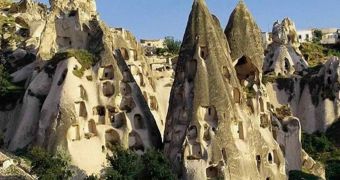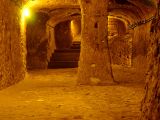This is the Turkish World's Wonder. In the residual relief made of tuffs and basalt lava, persecuted Christians carved churches, monasteries and dwellings.
Goreme National Park, with a surface of 9,576 hectares, is located in central Anatolia, between the volcanic mountains Hasan and Erciyes, in the Nevsehir Province, 83 km (52 mi) off Nigde. In the volcanic rocks, erosion carved mighty shapes protected by the basalt coverlet. But the originality of the area is given by the fact that these forms of natural erosion were easily carved by the ancient inhabitants of the area.
Cappadocia has been continuously inhabited since pre-Christian era up to present days. Monasteries, hermitages, shrines and even dwellings were carved in the tuffs. The carved grottoes reflect the Byzantine architecture, style and painting. Most of the dwellings and chapels date from the 10th -13th centuries.
The territory of Cappadocia is on the east-west trade route and formerly was often a war theater for the confrontations between the Byzantine and Arab/Muslim troops, between the 7th and the 12th century. The Christian inhabitants felt under a constant menace, so that, for defending and keeping their cult, they carved two large subterranean cities, at Kaymakli and Derinkuyu, and numerous other subterranean refuges.
The city of Derinkuyu had 12 underground levels, comprising 12,000 rooms. When required, it could shelter 10,000 people. A subterranean road, 10 km (6 mi) long connected it to the city of Kaymakli, which had the same number of rooms and levels.
Following the Battle of Manzikert, fought nearby in August of 1071, one of the worst defeats in Byzantine history, the Seljuk Turks coming from Iran spread into Anatolia, pushing forever the borders of the Byzantine empire westwards. It was the moment when Asia Minor (Anatolia) turned from Christian into Turkish and Muslim. But the Muslim Turks did not oppress the Christian communities refuged here. These Christians continued to live, keeping their traditions and cohabiting with the new comers.
The fertile soil nearby was favorable to vineyards, plantations and crops, cultivated in small gardens. Crafts like carpet weaving and pottery flourished.
The park comprises two towns: Goreme and Cavusini. Cavusini is a museum in the open, with frescoes decorating the relief forms carved by nature in tuffs and describing the life of Christ. But the faces of the saints were destroyed during the 14th century. A rock carved monastery dedicated to Saint George is found at Cavusini.

 14 DAY TRIAL //
14 DAY TRIAL // 
